Development and Assessment of GIS-Based Landslide Susceptibility Mapping Models Using ANN, Fuzzy-AHP, and MCDA in Darjeeling Himalayas, West Bengal, India
Abstract
1. Introduction
2. Materials and Methods
2.1. Study Area
2.2. Data Sources
2.3. Landslide Inventory Map
2.4. Landslide Conditioning Factors
2.4.1. Slope
2.4.2. Aspect
2.4.3. Profile Curvature
2.4.4. Drainage Density
2.4.5. Soil Texture
2.4.6. Geomorphology
2.4.7. Lithology
2.4.8. Lineament Density
2.4.9. Rainfall
2.4.10. Land Use and Land Cover
2.5. Models Used for Landslide Susceptibility Mapping
2.5.1. Analytical Hierarchy Process (AHP)
2.5.2. Fuzzy-Based Analytical Hierarchy Process (Fuzzy-AHP)
2.5.3. Artificial Neural Network (ANN)
2.5.4. Parameter Effectiveness of the Model
2.5.5. Performance Evaluation of the Model
3. Results
3.1. Multicollinearity Test and Correlation Results
3.2. Model Results
3.2.1. Assessment Using AHP Model
3.2.2. Assessment Using Fuzzy-AHP Model
3.2.3. Assessment Using ANN Model
3.3. Model Validation
4. Discussion
5. Conclusions
Author Contributions
Funding
Acknowledgments
Conflicts of Interest
References
- Petley, D. Global patterns of loss of life from landslides. Geology 2012, 40, 927–930. [Google Scholar] [CrossRef]
- Kjekstad, O.; Highland, L. Economic and social impacts of landslides. In Landslides—Disaster Risk Reduction; Springer: Berlin/Heidelberg, Germany, 2009; pp. 573–587. [Google Scholar]
- Skilodimou, H.D.; Bathrellos, G.D.; Koskeridou, E.; Soukis, K.; Rozos, D. Physical and anthropogenic factors related to landslide activity in the Northern Peloponnese, Greece. Land 2018, 7, 85. [Google Scholar] [CrossRef]
- Fan, X.; Scaringi, G.; Korup, O.; West, A.J.; van Westen, C.J.; Tanyas, H.; Hovius, N.; Hales, T.C.; Jibson, R.W.; Allstadt, K.E.; et al. Earthquake-induced chains of geologic hazards: Patterns, mechanisms, and impacts. Rev. Geophys. 2019, 57, 421–503. [Google Scholar] [CrossRef]
- Dang, V.-H.; Hoang, N.-D.; Nguyen, L.-M.-D.; Bui, D.T.; Samui, P. A novel GIS-based random forest machine algorithm for the spatial prediction of shallow landslide susceptibility. Forests 2020, 11, 118. [Google Scholar] [CrossRef]
- Guzzetti, F.; Mondini, A.C.; Cardinali, M.; Fiorucci, F.; Santangelo, M.; Chang, K.-T. Landslide inventory maps: New tools for an old problem. Earth-Sci. Rev. 2012, 112, 42–66. [Google Scholar] [CrossRef]
- Guzzetti, F.; Carrara, A.; Cardinali, M.; Reichenbach, P. Landslide hazard evaluation: A review of current techniques and their application in a multi-scale study, Central Italy. Geomorphology 1999, 31, 181–216. [Google Scholar] [CrossRef]
- Li, C.; Fu, Z.; Wang, Y.; Tang, H.; Yan, J.; Gong, W.; Yao, W.; Criss, R.E. Susceptibility of reservoir-induced landslides and strategies for increasing the slope stability in the Three Gorges Reservoir Area: Zigui Basin as an example. Eng. Geol. 2019, 261, 105279. [Google Scholar] [CrossRef]
- Haque, U.; Da Silva, P.F.; Devoli, G.; Pilz, J.; Zhao, B.; Khaloua, A.; Wilopo, W.; Andersen, P.; Lu, P.; Lee, J.; et al. The human cost of global warming: Deadly landslides and their triggers (1995–2014). Sci. Total Environ. 2019, 682, 673–684. [Google Scholar] [CrossRef]
- Froude, M.J.; Petley, D.N. Global fatal landslide occurrence from 2004 to 2016. Nat. Hazards Earth Syst. Sci. 2018, 18, 2161–2181. [Google Scholar] [CrossRef]
- Dou, J.; Yunus, A.P.; Tien Bui, D.; Sahana, M.; Chen, C.-W.; Zhu, Z.; Wang, W.; Pham, B.T. Evaluating GIS-based multiple statistical models and data mining for earthquake and rainfall-induced landslide susceptibility using the LiDAR DEM. Remote Sens. 2019, 11, 638. [Google Scholar] [CrossRef]
- Van Westen, C.J.; Castellanos, E.; Kuriakose, S.L. Spatial data for landslide susceptibility, hazard, and vulnerability assessment: An overview. Eng. Geol. 2008, 102, 112–131. [Google Scholar] [CrossRef]
- Merghadi, A.; Yunus, A.P.; Dou, J.; Whiteley, J.; ThaiPham, B.; Bui, D.T.; Avtar, R.; Abderrahmane, B. Machine learning methods for landslide susceptibility studies: A comparative overview of algorithm performance. Earth-Sci. Rev. 2020, 207, 103225. [Google Scholar] [CrossRef]
- Chang, K.-T.; Merghadi, A.; Yunus, A.P.; Pham, B.T.; Dou, J. Evaluating scale effects of topographic variables in landslide susceptibility models using GIS-based machine learning techniques. Sci. Rep. 2019, 9, 12296. [Google Scholar] [CrossRef] [PubMed]
- Pham, B.T.; Jaafari, A.; Prakash, I.; Bui, D.T. A novel hybrid intelligent model of support vector machines and the MultiBoost ensemble for landslide susceptibility modeling. Bull. Eng. Geol. Environ. 2019, 78, 2865–2886. [Google Scholar] [CrossRef]
- Selamat, S.N.; Majid, N.A.; Taha, M.R.; Osman, A. Landslide Susceptibility Model Using Artificial Neural Network (ANN) Approach in Langat River Basin, Selangor, Malaysia. Land 2022, 11, 833. [Google Scholar] [CrossRef]
- Carabella, C.; Cinosi, J.; Piattelli, V.; Burrato, P.; Miccadei, E. Earthquake-induced landslides susceptibility evaluation: A case study from the Abruzzo region (Central Italy). Catena 2022, 208, 105729. [Google Scholar] [CrossRef]
- Whiteley, J.S.; Chambers, J.E.; Uhlemann, S.; Wilkinson, P.B.; Kendall, J.M. Geophysical monitoring of moisture-induced landslides: A review. Rev. Geophys. 2019, 57, 106–145. [Google Scholar] [CrossRef]
- Van Den Eeckhaut, M.; Kerle, N.; Poesen, J.; Hervás, J. Object-oriented identification of forested landslides with derivatives of single pulse LiDAR data. Geomorphology 2012, 173, 30–42. [Google Scholar] [CrossRef]
- Ding, A.; Zhang, Q.; Zhou, X.; Dai, B. Automatic recognition of landslide based on CNN and texture change detection. In Proceedings of the 2016 31st Youth Academic Annual Conference of Chinese Association of Automation (YAC), Wuhan, China, 11–13 November 2016; pp. 444–448. [Google Scholar]
- Yu, H.; Ma, Y.; Wang, L.; Zhai, Y.; Wang, X. A landslide intelligent detection method based on CNN and RSG\_R. In Proceedings of the 2017 IEEE International Conference on Mechatronics and Automation (ICMA), Takamatsu, Japan, 6–9 August 2017; pp. 40–44. [Google Scholar]
- Saha, S.; Sarkar, R.; Roy, J.; Hembram, T.K.; Acharya, S.; Thapa, G.; Drukpa, D. Measuring landslide vulnerability status of Chukha, Bhutan using deep learning algorithms. Sci. Rep. 2021, 11, 16374. [Google Scholar] [CrossRef]
- Kumar, D.; Thakur, M.; Dubey, C.S.; Shukla, D.P. Landslide susceptibility mapping & prediction using support vector machine for Mandakini River Basin, Garhwal Himalaya, India. Geomorphology 2017, 295, 115–125. [Google Scholar]
- Roy, J.; Saha, S. Landslide susceptibility mapping using knowledge driven statistical models in Darjeeling District, West Bengal, India. Geoenvironmental Disasters 2019, 6, 1–18. [Google Scholar] [CrossRef]
- Kanungo, D.P.; Arora, M.K.; Sarkar, S.; Gupta, R.P. A comparative study of conventional, ANN black box, fuzzy and combined neural and fuzzy weighting procedures for landslide susceptibility zonation in Darjeeling Himalayas. Eng. Geol. 2006, 85, 347–366. [Google Scholar] [CrossRef]
- Fell, R.; Corominas, J.; Bonnard, C.; Cascini, L.; Leroi, E.; Savage, W.Z. Guidelines for landslide susceptibility, hazard and risk zoning for land-use planning. Eng. Geol. 2008, 102, 99–111. [Google Scholar] [CrossRef]
- Tanyaş, H.; van Westen, C.J.; Allstadt, K.E.; Jibson, R.W. Factors controlling landslide frequency–area distributions. Earth Surf. Processes Landf. 2019, 44, 900–917. [Google Scholar] [CrossRef]
- Achour, Y.; Boumezbeur, A.; Hadji, R.; Chouabbi, A.; Cavaleiro, V.; Bendaoud, E.A. Landslide susceptibility mapping using analytic hierarchy process and information value methods along a highway road section in Constantine, Algeria. Arab. J. Geosci. 2017, 10, 194. [Google Scholar] [CrossRef]
- Mallick, J.; Singh, R.K.; AlAwadh, M.A.; Islam, S.; Khan, R.A.; Qureshi, M.N. GIS-based landslide susceptibility evaluation using fuzzy-AHP multi-criteria decision-making techniques in the Abha Watershed, Saudi Arabia. Environ. Earth Sci. 2018, 77, 276. [Google Scholar] [CrossRef]
- Lee, S.; Sambath, T. Landslide susceptibility mapping in the Damrei Romel area, Cambodia using frequency ratio and logistic regression models. Environ. Geol. 2006, 50, 847–855. [Google Scholar] [CrossRef]
- Greco, R.; Sorriso-Valvo, M.; Catalano, E. Logistic regression analysis in the evaluation of mass movements susceptibility: The Aspromonte case study, Calabria, Italy. Eng. Geol. 2007, 89, 47–66. [Google Scholar] [CrossRef]
- Kanwal, S.; Atif, S.; Shafiq, M. GIS based landslide susceptibility mapping of northern areas of Pakistan, a case study of Shigar and Shyok Basins. Geomat. Nat. Hazards Risk 2017, 8, 348–366. [Google Scholar] [CrossRef]
- Arabameri, A.; Pradhan, B.; Rezaei, K.; Lee, S.; Sohrabi, M. An ensemble model for landslide susceptibility mapping in a forested area. Geocarto Int. 2019, 35, 1680–1705. [Google Scholar] [CrossRef]
- Mandal, S.; Mondal, S. Machine Learning Models and Spatial Distribution of Landslide Susceptibility. In Geoinformatics and Modelling of Landslide Susceptibility and Risk; Springer: Berlin/Heidelberg, Germany, 2019; pp. 165–175. [Google Scholar]
- Chawla, S.; Chawla, A.; Pasupuleti, S. A Feasible Approach for Landslide Susceptibility Map Using GIS. Geotech. Spec. Publ. 2017, 2017, 101–110. [Google Scholar] [CrossRef]
- Mandal, B.; Mandal, S. Analytical hierarchy process (AHP) based landslide susceptibility mapping of Lish river basin of eastern Darjeeling Himalaya, India. Adv. Space Res. 2018, 62, 3114–3132. [Google Scholar] [CrossRef]
- Basu, T.; Pal, S. RS-GIS based morphometrical and geological multi-criteria approach to the landslide susceptibility mapping in Gish River Basin, West Bengal, India. Adv. Space Res. 2019, 63, 1253–1269. [Google Scholar] [CrossRef]
- Arabameri, A.; Cerda, A.; Tiefenbacher, J.P. Spatial pattern analysis and prediction of gully erosion using novel hybrid model of entropy-weight of evidence. Water 2019, 11, 1129. [Google Scholar] [CrossRef]
- Bera, A.; Mukhopadhyay, B.P.; Das, D. Landslide hazard zonation mapping using multi-criteria analysis with the help of GIS techniques: A case study from Eastern Himalayas, Namchi, South Sikkim. Nat. Hazards 2019, 96, 935–959. [Google Scholar] [CrossRef]
- Chen, Y.; Khan, S.; Paydar, Z. To retire or expand? A fuzzy GIS-based spatial multi-criteria evaluation framework for irrigated agriculture. Irrig. Drain. 2010, 59, 174–188. [Google Scholar] [CrossRef]
- Feizizadeh, B.; Blaschke, T. GIS-multicriteria decision analysis for landslide susceptibility mapping: Comparing three methods for the Urmia lake basin, Iran. Nat. Hazards 2013, 65, 2105–2128. [Google Scholar] [CrossRef]
- Kolat, C.; Ulusay, R.; Suzen, M.L. Development of geotechnical microzonation model for Yenisehir (Bursa, Turkey) located at a seismically active region. Eng. Geol. 2012, 127, 36–53. [Google Scholar] [CrossRef]
- Saaty, T.L. Decision making with the analytic hierarchy process. Int. J. Serv. Sci. 2008, 1, 83–98. [Google Scholar]
- Zadeh, L.A. Fuzzy sets. In Fuzzy Sets, Fuzzy Logic, and Fuzzy Systems: Selected Papers by Lotfi a Zadeh; World Scientific: Singapore, 1996; pp. 394–432. [Google Scholar]
- Balezentiene, L.; Streimikiene, D.; Balezentis, T. Fuzzy decision support methodology for sustainable energy crop selection. Renew. Sustain. Energy Rev. 2013, 17, 83–93. [Google Scholar] [CrossRef]
- Zadeh, L.A. Studies in Fuzziness and Soft Computing: Foreword; Springer: Berlin/Heidelberg, Germany, 2010; T. 261; ISBN 9783642166280. [Google Scholar]
- Kahraman, C.; Cebeci, U.; Ulukan, Z. Multi-criteria supplier selection using fuzzy AHP. Logist. Inf. Manag. 2003, 16, 382–394. [Google Scholar] [CrossRef]
- Chen, V.Y.C.; Lien, H.-P.; Liu, C.-H.; Liou, J.J.H.; Tzeng, G.-H.; Yang, L.-S. Fuzzy MCDM approach for selecting the best environment-watershed plan. Appl. Soft Comput. 2011, 11, 265–275. [Google Scholar] [CrossRef]
- Buckley, J.J. Fuzzy hierarchical analysis. Fuzzy Sets Syst. 1985, 17, 233–247. [Google Scholar] [CrossRef]
- Can, R.; Kocaman, S.; Gokceoglu, C. A convolutional neural network architecture for auto-detection of landslide photographs to assess citizen science and volunteered geographic information data quality. ISPRS Int. J. Geo-Inf. 2019, 8, 300. [Google Scholar] [CrossRef]
- Li, B.; Wang, N.; Chen, J. GIS-based landslide susceptibility mapping using information, frequency ratio, and artificial neural network methods in Qinghai Province, Northwestern China. Adv. Civ. Eng. 2021, 2021, 1–14. [Google Scholar] [CrossRef]
- Oh, H.-J.; Lee, S. Shallow landslide susceptibility modeling using the data mining models artificial neural network and boosted tree. Appl. Sci. 2017, 7, 1000. [Google Scholar] [CrossRef]
- Al-Najjar, H.A.H.; Pradhan, B. Spatial landslide susceptibility assessment using machine learning techniques assisted by additional data created with generative adversarial networks. Geosci. Front. 2021, 12, 625–637. [Google Scholar] [CrossRef]
- Chen, W.; Chen, Y.; Tsangaratos, P.; Ilia, I.; Wang, X. Combining evolutionary algorithms and machine learning models in landslide susceptibility assessments. Remote Sens. 2020, 12, 3854. [Google Scholar] [CrossRef]
- Arabameri, A.; Pradhan, B.; Rezaei, K. Gully erosion zonation mapping using integrated geographically weighted regression with certainty factor and random forest models in GIS. J. Environ. Manag. 2019, 232, 928–942. [Google Scholar] [CrossRef]
- Arabameri, A.; Pourghasemi, H.R.; Yamani, M. Applying different scenarios for landslide spatial modeling using computational intelligence methods. Environ. Earth Sci. 2017, 76, 832. [Google Scholar] [CrossRef]
- Chen, W.; Lei, X.; Chakrabortty, R.; Chandra Pal, S.; Sahana, M.; Janizadeh, S. Evaluation of different boosting ensemble machine learning models and novel deep learning and boosting framework for head-cut gully erosion susceptibility. J. Environ. Manag. 2021, 284, 112015. [Google Scholar] [CrossRef] [PubMed]
- Zhao, P.; Masoumi, Z.; Kalantari, M.; Aflaki, M.; Mansourian, A. A GIS-Based Landslide Susceptibility Mapping and Variable Importance Analysis Using Artificial Intelligent Training-Based Methods. Remote Sens. 2022, 14, 211. [Google Scholar] [CrossRef]
- Sengupta, A.; Nath, S.K. GIS-Based Landslide Susceptibility Mapping in Eastern Boundary Zone of Northeast India in Compliance with Indo-Burmese Subduction Tectonics. In Geospatial Technology for Environmental Hazards; Springer: Berlin/Heidelberg, Germany, 2022; pp. 19–37. [Google Scholar]
- Tien Bui, D.; Tuan, T.A.; Klempe, H.; Pradhan, B.; Revhaug, I. Spatial prediction models for shallow landslide hazards: A comparative assessment of the efficacy of support vector machines, artificial neural networks, kernel logistic regression, and logistic model tree. Landslides 2016, 13, 361–378. [Google Scholar] [CrossRef]
- Nhu, V.-H.; Mohammadi, A.; Shahabi, H.; Ahmad, B.B.; Al-Ansari, N.; Shirzadi, A.; Clague, J.J.; Jaafari, A.; Chen, W.; Nguyen, H. Landslide susceptibility mapping using machine learning algorithms and remote sensing data in a tropical environment. Int. J. Environ. Res. Public Health 2020, 17, 4933. [Google Scholar] [CrossRef] [PubMed]
- Mokhtari, M.; Abedian, S. Spatial prediction of landslide susceptibility in Taleghan basin, Iran. Stoch. Environ. Res. Risk Assess. 2019, 33, 1297–1325. [Google Scholar] [CrossRef]
- Gautam, P.; Kubota, T.; Sapkota, L.M.; Shinohara, Y. Landslide susceptibility mapping with GIS in high mountain area of Nepal: A comparison of four methods. Environ. Earth Sci. 2021, 80, 1–18. [Google Scholar] [CrossRef]
- Sujatha, E.R.; Sridhar, V. Landslide susceptibility analysis: A logistic regression model case study in Coonoor, India. Hydrology 2021, 8, 41. [Google Scholar] [CrossRef]
- Arabameri, A.; Pradhan, B.; Rezaei, K.; Conoscenti, C. Gully erosion susceptibility mapping using GIS-based multi-criteria decision analysis techniques. Catena 2019, 180, 282–297. [Google Scholar] [CrossRef]
- Nam, K.; Wang, F. An extreme rainfall-induced landslide susceptibility assessment using autoencoder combined with random forest in Shimane Prefecture, Japan. Geoenvironmental Disasters 2020, 7, 6. [Google Scholar] [CrossRef]
- Azarafza, M.; Azarafza, M.; Akgün, H.; Atkinson, P.M.; Derakhshani, R. Deep learning-based landslide susceptibility mapping. Sci. Rep. 2021, 11, 24112. [Google Scholar] [CrossRef]
- Xing, Y.; Yue, J.; Guo, Z.; Chen, Y.; Hu, J.; Travé, A. Large-scale landslide susceptibility mapping using an integrated machine learning model: A case study in the Lvliang Mountains of China. Front. Earth Sci. 2021, 622. [Google Scholar] [CrossRef]
- van Westen, C.J.; van Asch, T.W.J.; Soeters, R. Landslide hazard and risk zonation-Why is it still so difficult? Bull. Eng. Geol. Environ. 2006, 65, 167–184. [Google Scholar] [CrossRef]
- Roccati, A.; Paliaga, G.; Luino, F.; Faccini, F.; Turconi, L. GIS-based landslide susceptibility mapping for land use planning and risk assessment. Land 2021, 10, 162. [Google Scholar] [CrossRef]
- Mandal, K.; Saha, S.; Mandal, S. Applying deep learning and benchmark machine learning algorithms for landslide susceptibility modelling in Rorachu river basin of Sikkim Himalaya, India. Geosci. Front. 2021, 12, 101203. [Google Scholar] [CrossRef]
- Prakash, N.; Manconi, A.; Loew, S. A new strategy to map landslides with a generalized convolutional neural network. Sci. Rep. 2021, 11, 9722. [Google Scholar] [CrossRef]
- Park, S.; Kim, J. Landslide susceptibility mapping based on random forest and boosted regression tree models, and a comparison of their performance. Appl. Sci. 2019, 9, 942. [Google Scholar] [CrossRef]
- Constantin, M.; Bednarik, M.; Jurchescu, M.C.; Vlaicu, M. Landslide susceptibility assessment using the bivariate statistical analysis and the index of entropy in the Sibiciu Basin (Romania). Environ. Earth Sci. 2011, 63, 397–406. [Google Scholar] [CrossRef]
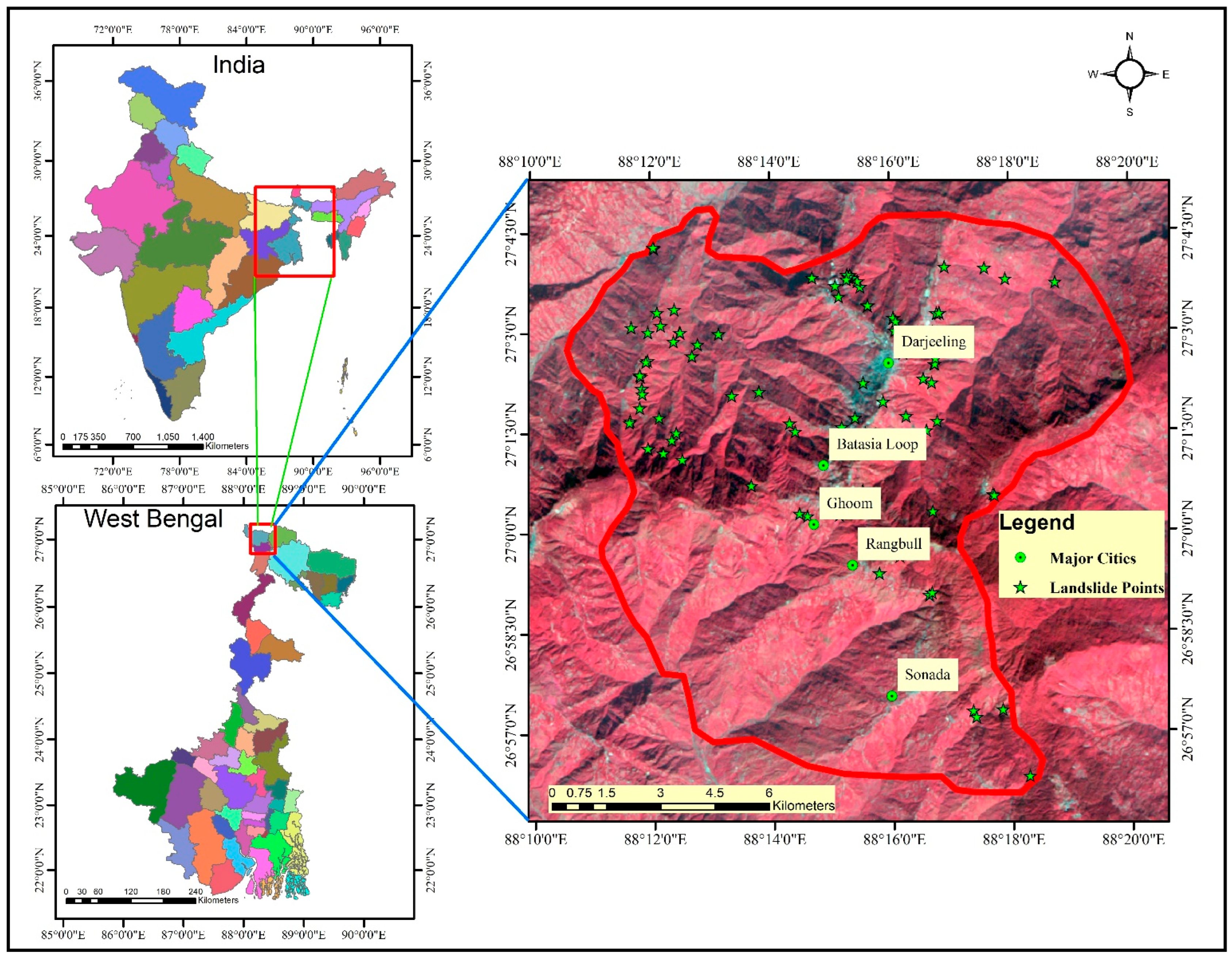

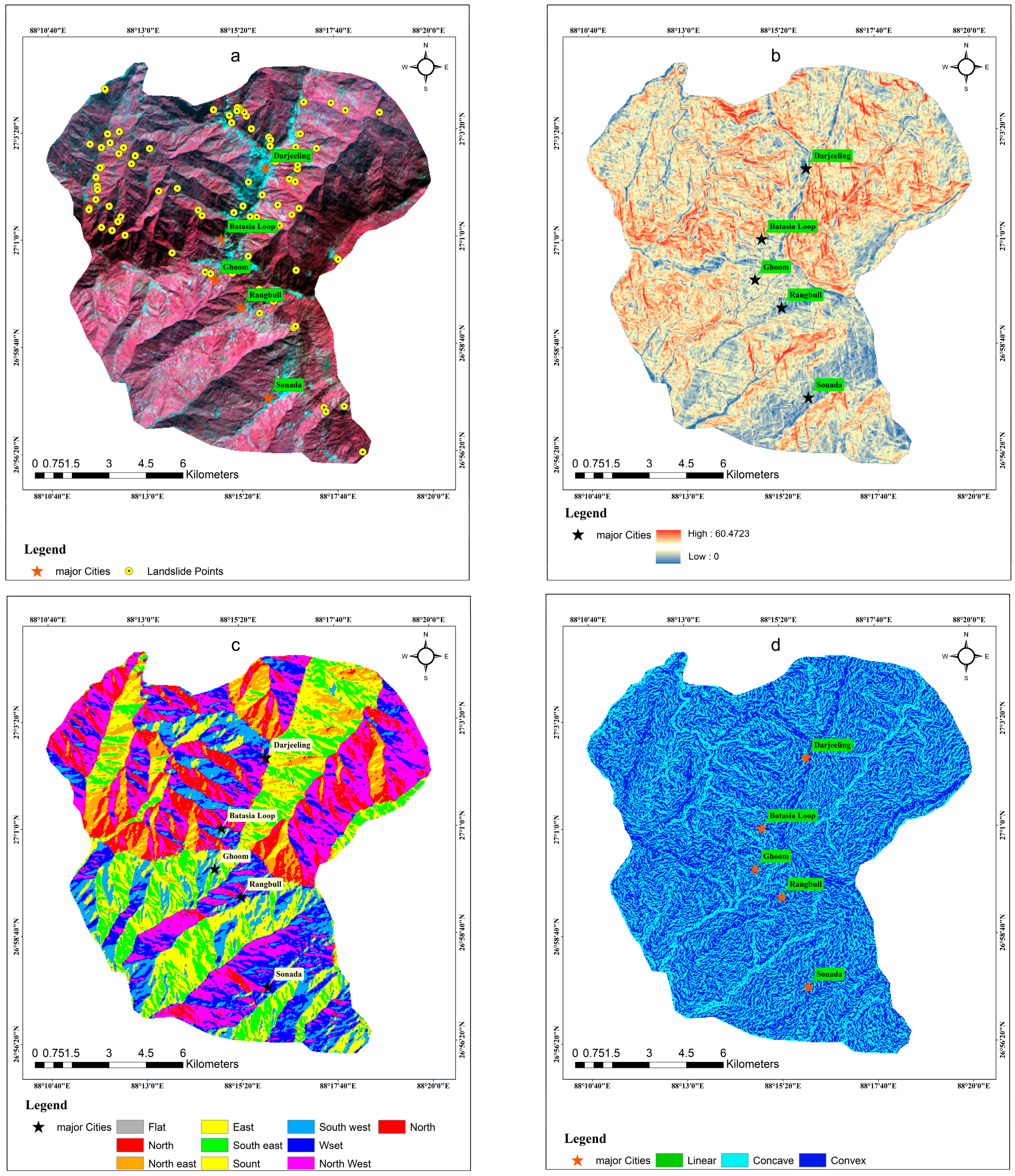
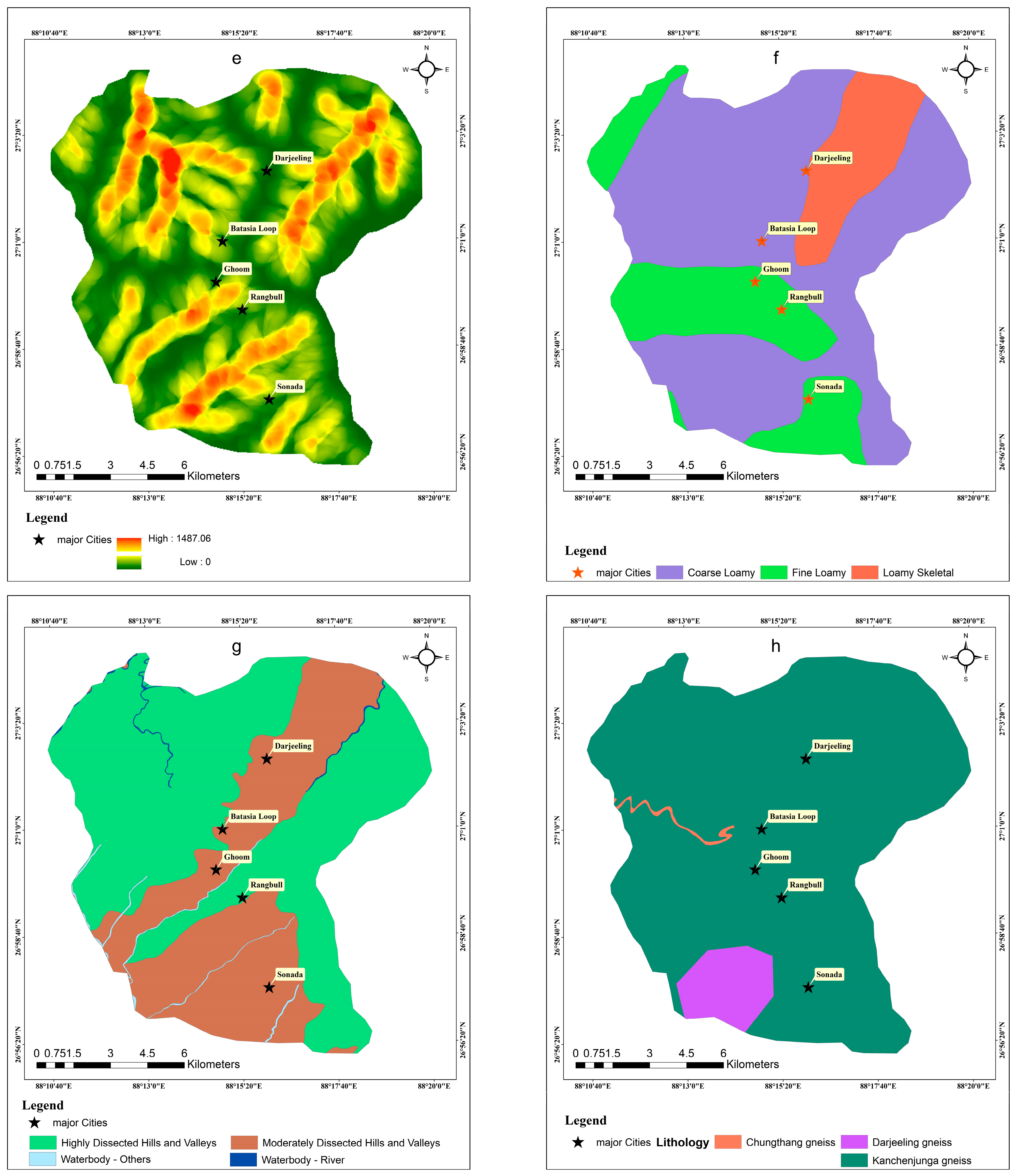
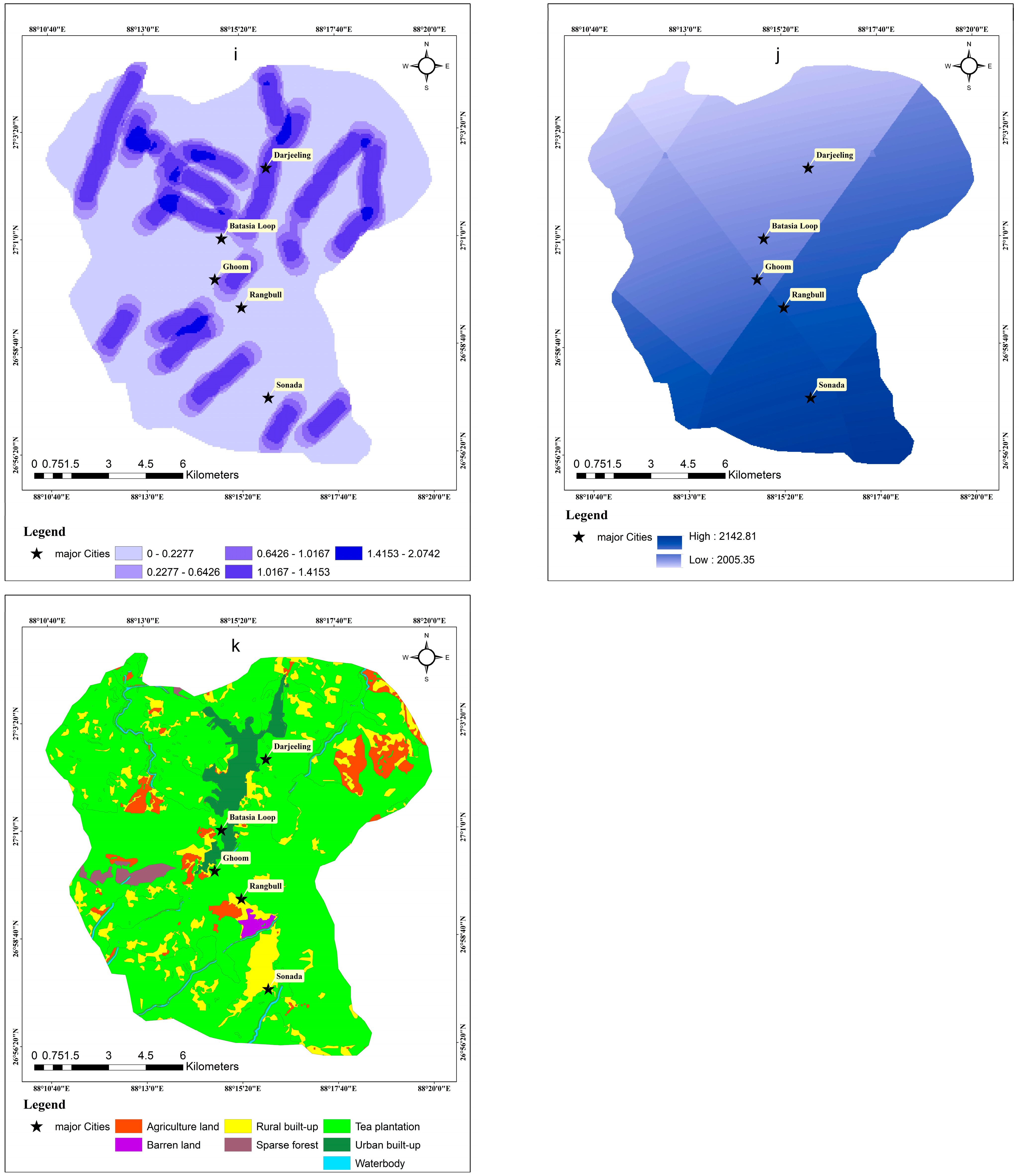
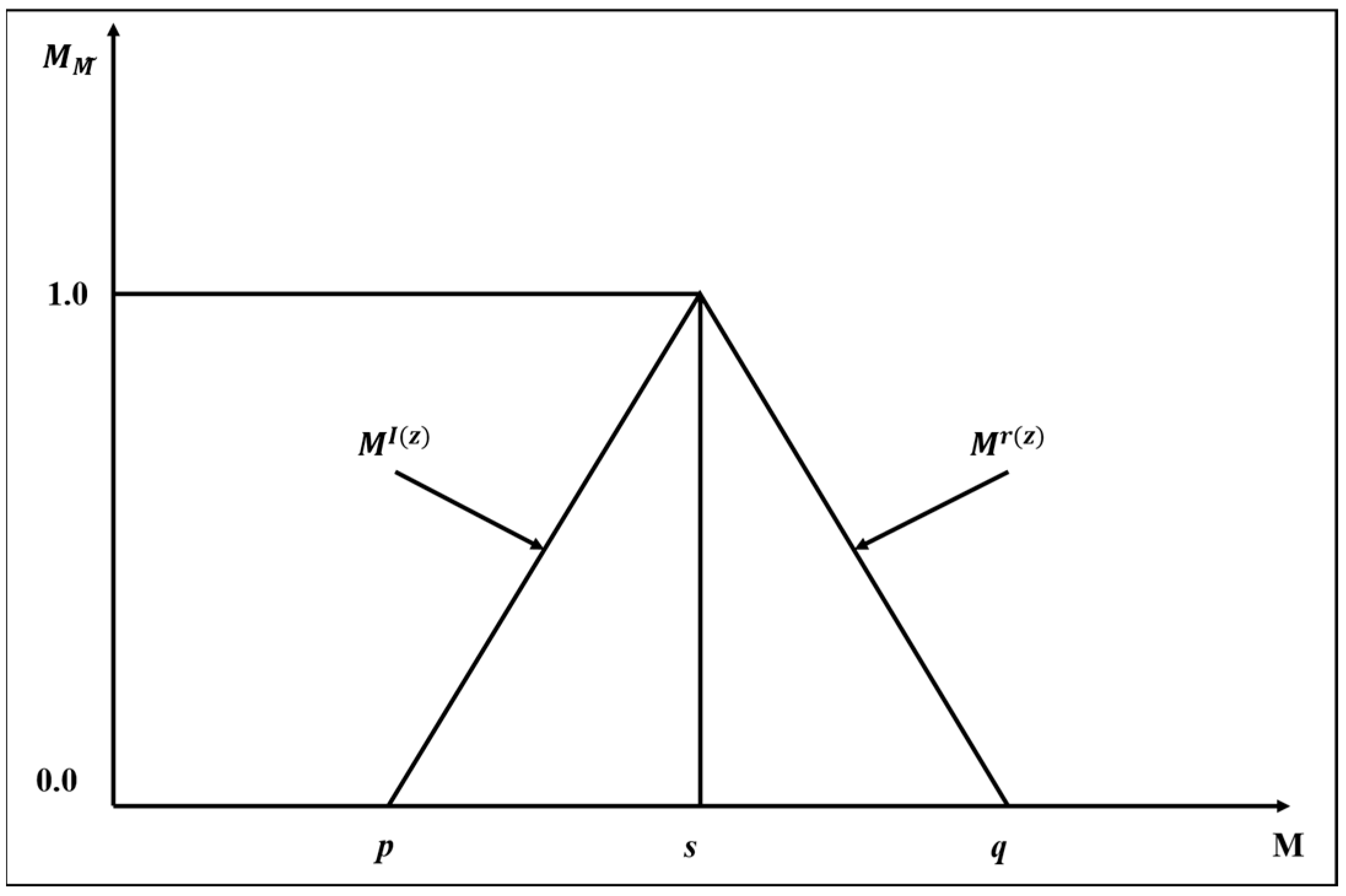
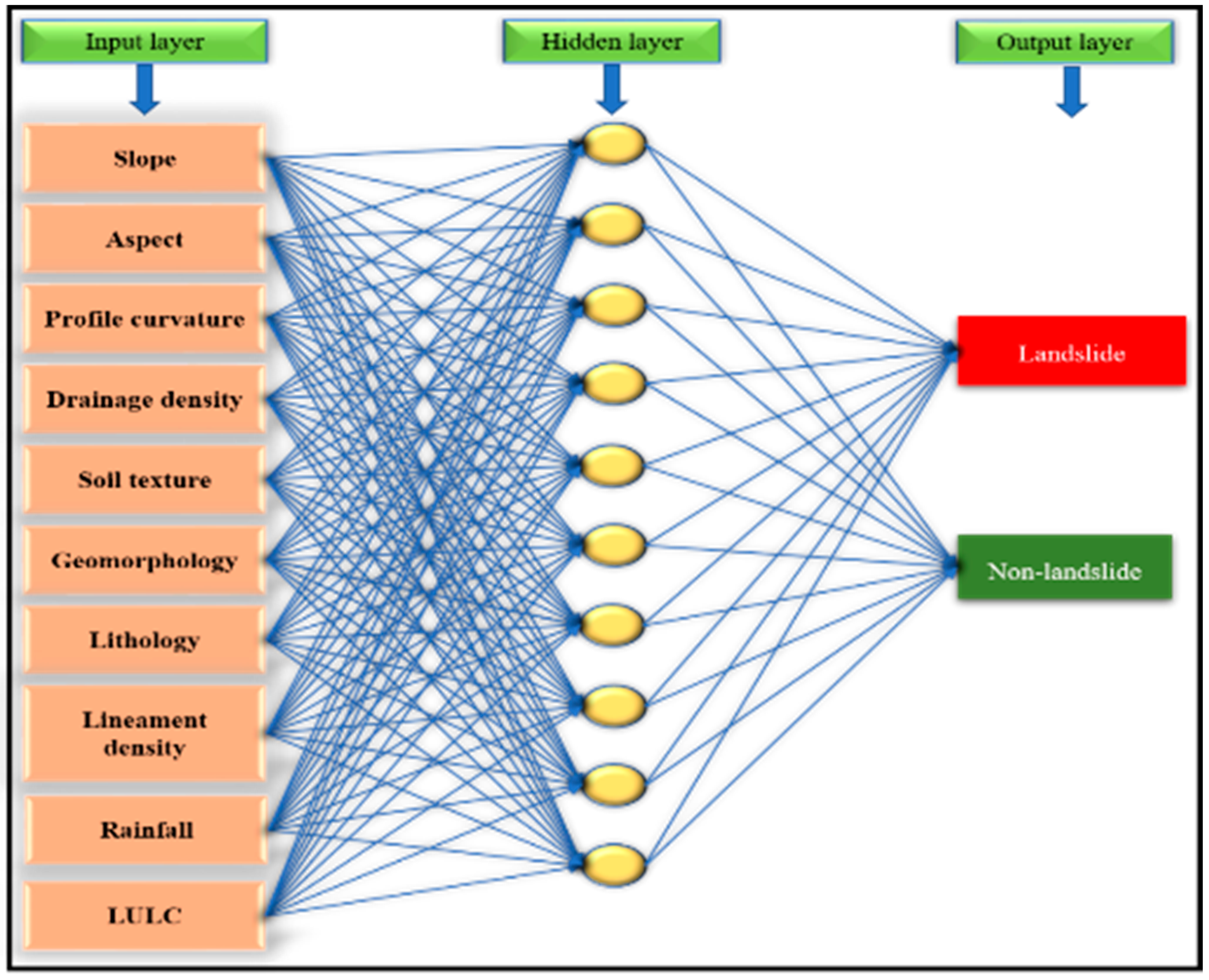
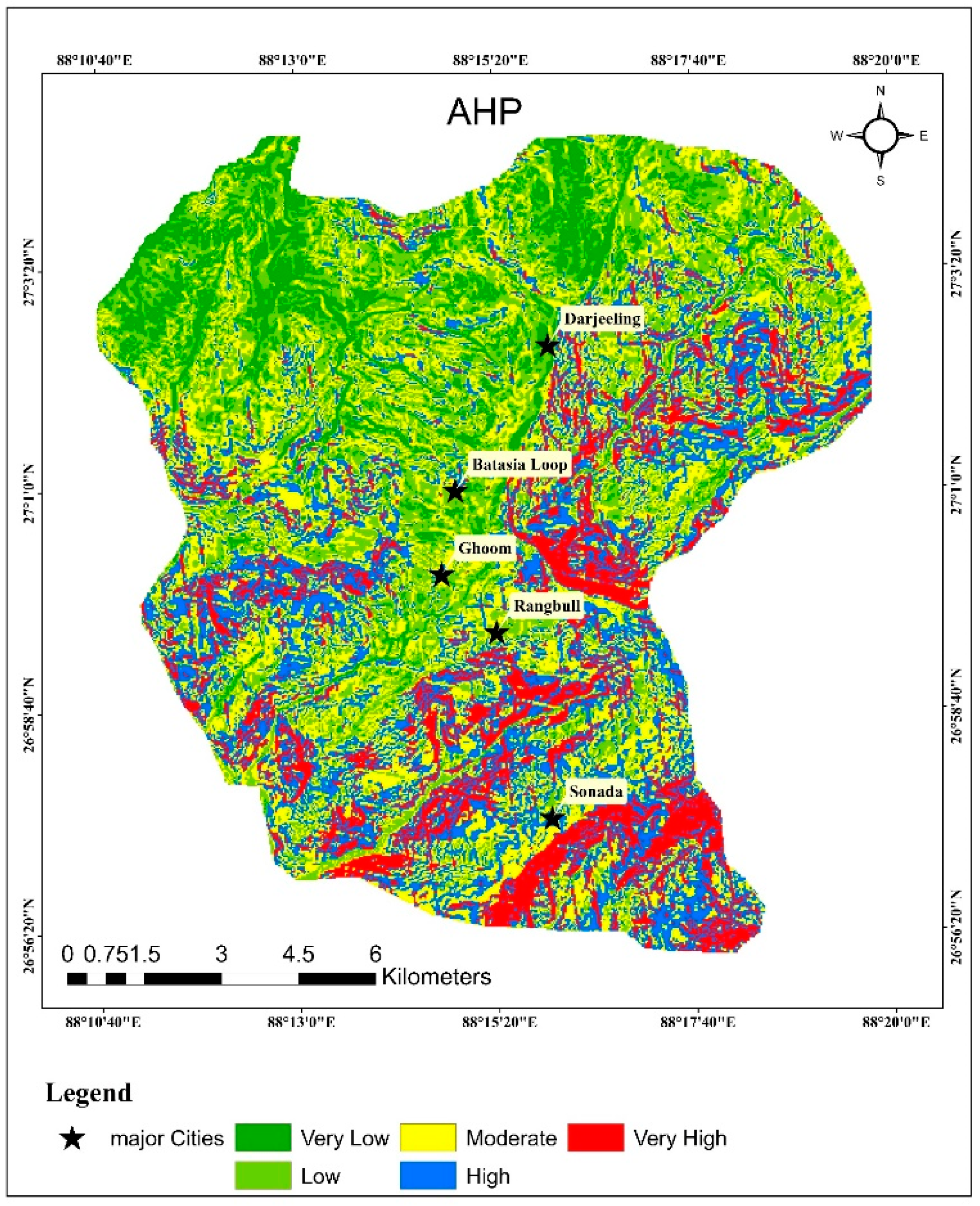


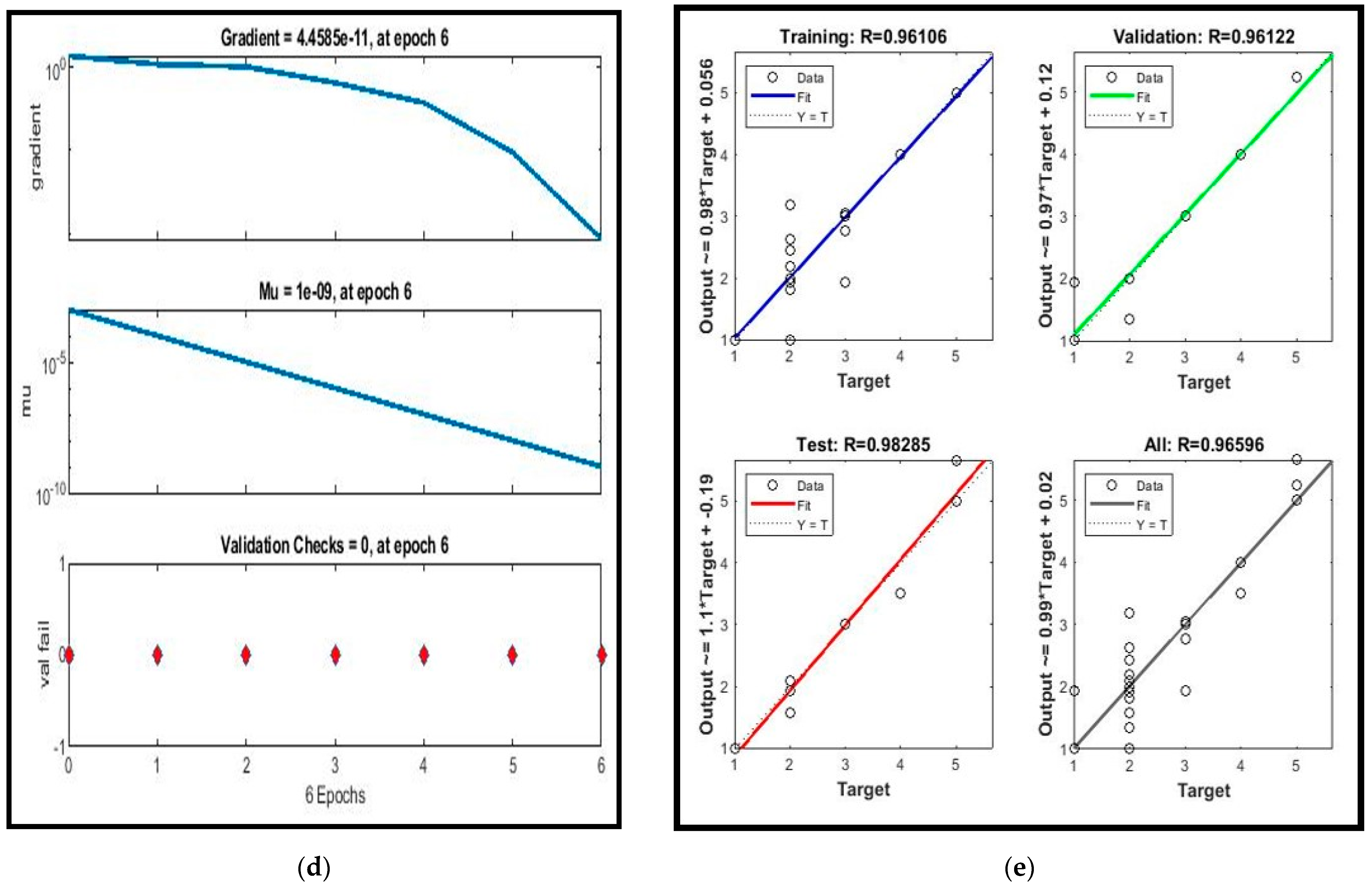
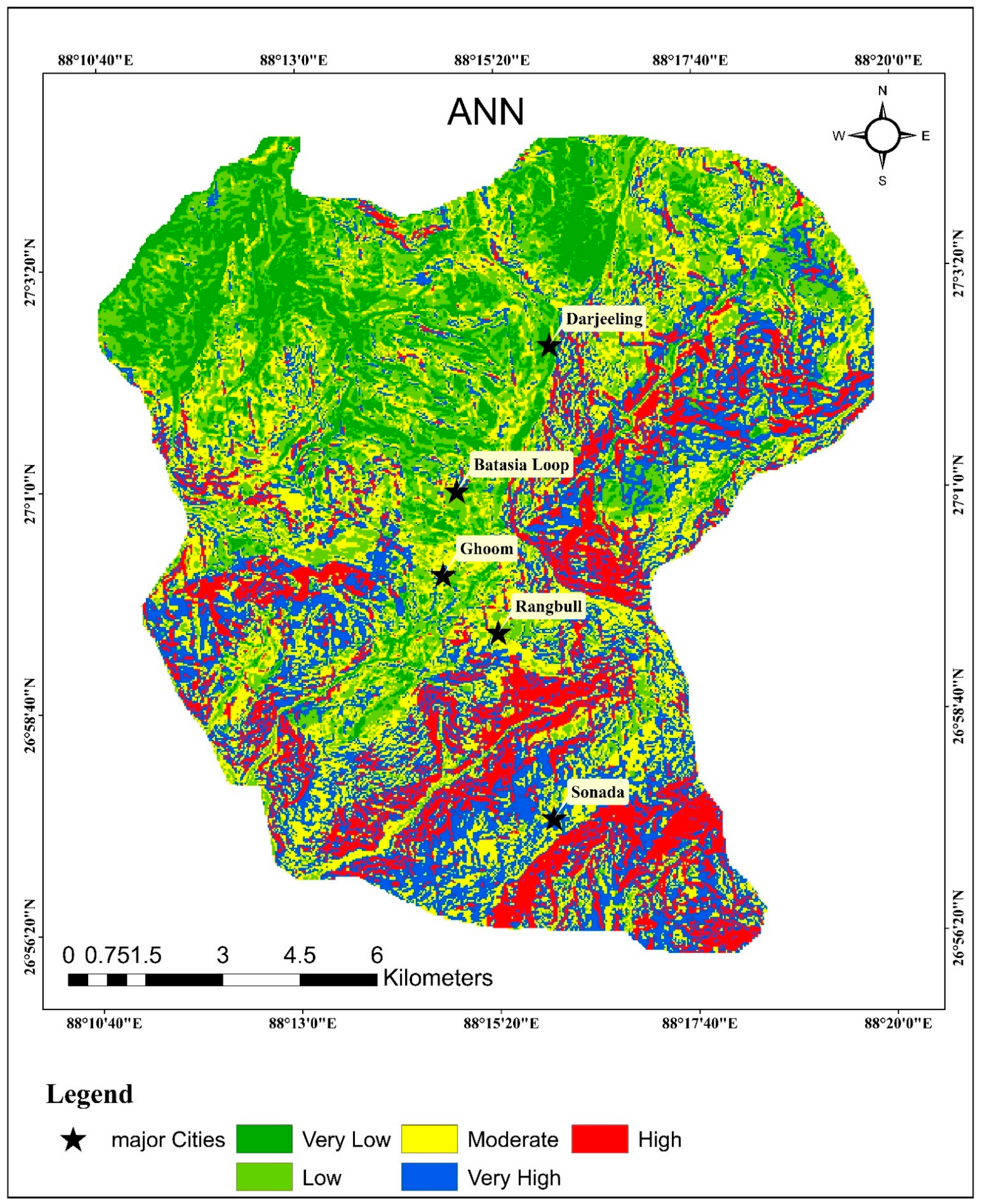


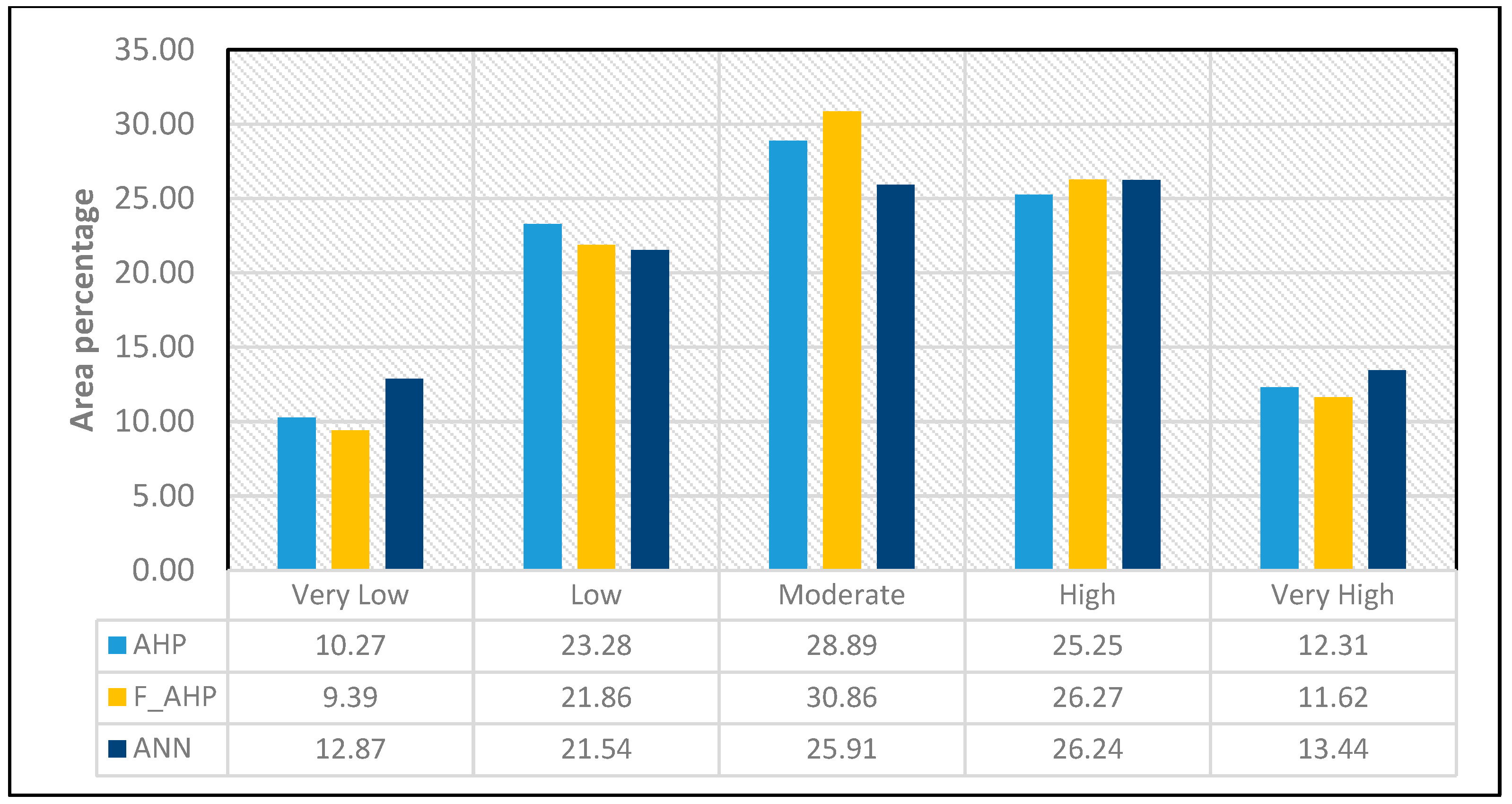
| Sl. No | Input Data | Spatial Resolution | Resultant Maps |
|---|---|---|---|
| 1 | ALOS PALSAR DEM | 12.5 m | Slope, aspect, profile curvature, drainage density, lineament density |
| 2 | Cartosat-2 series (MX) | 1.6 m | Land use and land cover |
| 4 | CRU data | Numerical | Rainfall |
| 5 | Geomorphology, lithology | -- | Geomorphology, lithology |
| 6 | Soil | -- | Soil texture |
| NO. | 1 | 2 | 3 | 4 | 5 | 6 | 7 | 8 | 9 | 10 |
|---|---|---|---|---|---|---|---|---|---|---|
| RI | 0 | 0 | 0.58 | 0.90 | 1.12 | 1.24 | 1.32 | 1.42 | 1.45 | 1.49 |
| Scale Weight | Triangular Fuzzy Scale | Scale Weight | Triangular Fuzzy Scale |
|---|---|---|---|
| 1 | (1,1,1) | 1/1 | (1/1, 1/1, 1/1) |
| 2 | (1,2,3) | 1/2 | (1/3, 1/2,1/1) |
| 3 | (2,3,4) | 1/3 | (1/4,1/3,1/2) |
| 4 | (3,4,5) | 1/4 | (1/5,1/4,1/3) |
| 5 | (4,5,6) | 1/5 | (1/6,1/5,1/4) |
| 6 | (5,6,7) | 1/6 | (1/7,1/6,1/5) |
| 7 | (6,7,8) | 1/7 | (1/8,1/7,1/6) |
| 8 | (7,8,9) | 1/8 | (1/9,1/8,1/7) |
| 9 | (9,9,9) | 1/9 | (1/9, 1/9, 1/9) |
| Sl. No | Class | Tolerance | VIF |
|---|---|---|---|
| 1 | Soil texture | 0.857 | 1.167 |
| 2 | Slope | 0.874 | 1.144 |
| 3 | Rainfall | 0.797 | 1.255 |
| 4 | Profile Curvature | 0.959 | 1.043 |
| 5 | Land use and land cover | 0.843 | 1.186 |
| 6 | Lithology | 0.944 | 1.060 |
| 7 | Lineament Density | 0.869 | 1.151 |
| 8 | Geomorphology | 0.816 | 1.225 |
| 9 | Drainage Density | 0.922 | 1.085 |
| 10 | Aspect | 0.745 | 1.342 |
| i | ii | iii | iv | v | vi | vii | viii | ix | x | Weight | |
|---|---|---|---|---|---|---|---|---|---|---|---|
| i | 1 | 1/2 | 1/3 | 1/5 | 1/5 | 1/7 | 1/7 | 1/8 | 1/8 | 1/9 | 0.0151 |
| ii | 2 | 1 | 1/2 | 1/3 | 1/4 | 1/5 | 1/5 | 1/7 | 1/7 | 1/9 | 0.0205 |
| iii | 3 | 2 | 1 | 1/2 | 1/2 | 1/3 | 1/3 | 1/5 | 1/5 | 1/7 | 0.0300 |
| iv | 5 | 3 | 2 | 1 | 1/2 | 1/3 | 1/4 | 1/4 | 1/5 | 1/7 | 0.0430 |
| v | 5 | 4 | 2 | 2 | 1 | 1/2 | 1/3 | 1/5 | 1/6 | 1/7 | 0.05160 |
| vi | 7 | 5 | 3 | 3 | 2 | 1 | 1/2 | 1/3 | 1/4 | 1/5 | 0.0789 |
| vii | 7 | 5 | 3 | 4 | 3 | 2 | 1 | 1/3 | 1/4 | 1/5 | 0.0949 |
| viii | 8 | 7 | 5 | 4 | 5 | 3 | 3 | 1 | 1/3 | 1/5 | 0.1431 |
| ix | 8 | 7 | 7 | 5 | 6 | 3 | 4 | 3 | 1 | 1/5 | 0.1994 |
| x | 9 | 9 | 9 | 7 | 7 | 5 | 5 | 5 | 3 | 1 | 0.3230 |
| i | ii | iii | iv | v | vi | vii | viii | ix | x | Weight | |
|---|---|---|---|---|---|---|---|---|---|---|---|
| i | 1,1,1 | 1/3,1/2,1/1 | 1/4,1/3,1/2 | 1/6,1/5,1/4 | 1/6,1/5,1/4 | 1/8,1/7,1/6 | 1/8,1/7,1/6 | 1/9,1/8,1/7 | 1/9,1/8,1/7 | 1/9,1/9,1/9 | 0.0146 |
| ii | 1,2,3 | 1,1,1 | 1/3,1/2,1/1 | 1/4,1/3,1/2 | 1/5,1/4,1/3 | 1/6,1/5,1/4 | 1/6,1/5,1/4 | 1/8,1/7,1/6 | 1/8,1/7,1/6 | 1/9,1/9,1/9 | 0.0209 |
| iii | 2,3,4 | 1,2,3 | 1,1,1 | 1/3,1/2,1/1 | 1/3,1/2,1/1 | 1/4,1/3,1/2 | 1/4,1/3,1/2 | 1/4,1/3,1/2 | 1/8,1/7,1/6 | 1/9,1/9,1/9 | 0.0327 |
| iv | 4,5,6 | 2,3,4 | 1,2,3 | 1,1,1 | 1/3,1/2,1/1 | 1/4,1/3,1/2 | 1/5,1/4,1/3 | 1/5,1/4,1/3 | 1/6,1/5,1/4 | 1/8,1/6,1/7 | 0.0427 |
| v | 4,5,6 | 3,4,5 | 1,2,3 | 1,2,3 | 1,1,1 | 1/3,1/2,1/1 | 1/4,1/3,1/2 | 1/6,1/5,1/4 | 1/7,1/6,1/5 | 1/8,1/6,1/7 | 0.0516 |
| vi | 6,7,8 | 4,5,6 | 2,3,4 | 2,3,4 | 1,2,3 | 1,1,1 | 1/3,1/2,1/1 | 1/4,1/3,1/2 | 1/4,1/3,1/2 | 1/6,1/5,1/4 | 0.0833 |
| vii | 6,7,8 | 4,5,6 | 2,3,4 | 3,4,5 | 2,3,4 | 1,2,3 | 1,1,1 | 1/4,1/3,1/2 | 1/6,1/5,1/4 | 1/6,1/5,1/4 | 0.0947 |
| viii | 7,8,9 | 6,7,8 | 4,5,6 | 3,4,5 | 4,5,6 | 2,3,4 | 2,3,4 | 1,1,1 | 1/4,1/3,1/2 | 1/4,1/3,1/2 | 0.1616 |
| ix | 7,8,9 | 6,7,8 | 6,7,8 | 4,5,6 | 5,6,7 | 2,3,4 | 3,4,5 | 2,3,4 | 1,1,1 | 1/4,1/3,1/2 | 0.2200 |
| x | 9,9,9 | 9,9,9 | 9,9,9 | 6,7,8 | 6,7,8 | 4,5,6 | 4,5,6 | 4,5,6 | 2,3,4 | 1,1,1 | 0.3344 |
Publisher’s Note: MDPI stays neutral with regard to jurisdictional claims in published maps and institutional affiliations. |
© 2022 by the authors. Licensee MDPI, Basel, Switzerland. This article is an open access article distributed under the terms and conditions of the Creative Commons Attribution (CC BY) license (https://creativecommons.org/licenses/by/4.0/).
Share and Cite
Saha, A.; Villuri, V.G.K.; Bhardwaj, A. Development and Assessment of GIS-Based Landslide Susceptibility Mapping Models Using ANN, Fuzzy-AHP, and MCDA in Darjeeling Himalayas, West Bengal, India. Land 2022, 11, 1711. https://doi.org/10.3390/land11101711
Saha A, Villuri VGK, Bhardwaj A. Development and Assessment of GIS-Based Landslide Susceptibility Mapping Models Using ANN, Fuzzy-AHP, and MCDA in Darjeeling Himalayas, West Bengal, India. Land. 2022; 11(10):1711. https://doi.org/10.3390/land11101711
Chicago/Turabian StyleSaha, Abhik, Vasanta Govind Kumar Villuri, and Ashutosh Bhardwaj. 2022. "Development and Assessment of GIS-Based Landslide Susceptibility Mapping Models Using ANN, Fuzzy-AHP, and MCDA in Darjeeling Himalayas, West Bengal, India" Land 11, no. 10: 1711. https://doi.org/10.3390/land11101711
APA StyleSaha, A., Villuri, V. G. K., & Bhardwaj, A. (2022). Development and Assessment of GIS-Based Landslide Susceptibility Mapping Models Using ANN, Fuzzy-AHP, and MCDA in Darjeeling Himalayas, West Bengal, India. Land, 11(10), 1711. https://doi.org/10.3390/land11101711











